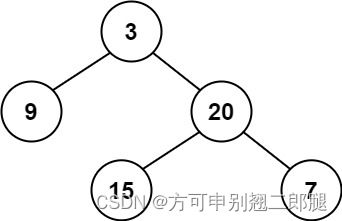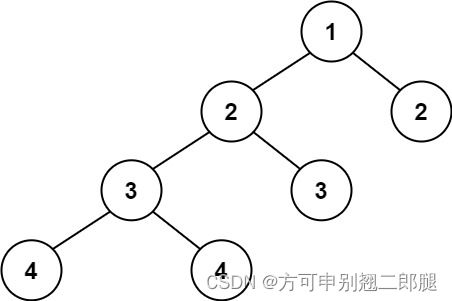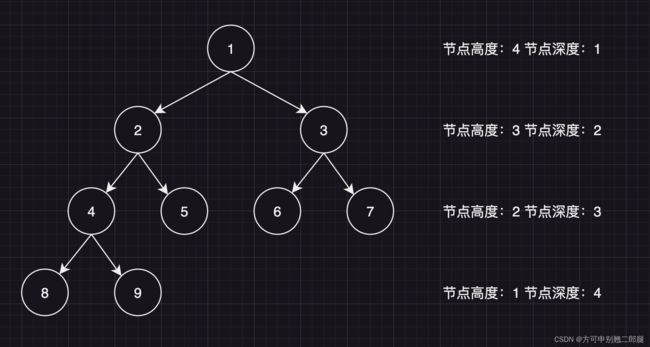代码随想录二刷 | 二叉树 | 110.平衡二叉树
代码随想录二刷 | 二叉树 | 110.平衡二叉树
- 题目描述
- 解题思路
-
- 递归
- 迭代
- 代码实现
-
- 递归法
- 迭代法
题目描述
110.平衡二叉树
给定一个二叉树,判断它是否是高度平衡的二叉树。
本题中,一棵高度平衡二叉树定义为:
一个二叉树每个节点 的左右两个子树的高度差的绝对值不超过 1 。
示例 1:

输入:root = [3,9,20,null,null,15,7]
输出:true
示例 2:

输入:root = [1,2,2,3,3,null,null,4,4]
输出:false
示例 3:
输入:root = []
输出:true
提示:
- 树中的节点数在范围 [0, 5000] 内
- -104 <= Node.val <= 104
解题思路
二叉树节点的高度:从根节点到该节点的最长简单路径边的条数
二叉树节点的深度:从该节点到叶子节点的最长简单路径变的条数

求深度可以从上到下去查询,所以需要前序遍历,而求高度只能从下到上去查,只能后序遍历。
因此本题使用后序遍历。
递归
递归三部曲
-
确定递归函数的参数和返回值
参数:当前传入的节点
返回值:因为求的是高度,所以为int如果当前传入节点为根节点的二叉树已经不是二叉平衡树了,还返回高度的话就没有意义了。
所以如果已经不是二叉平衡树了,可以返回 -1 来标记已经不符合平衡树的规则了。
int getHeight(TreeNode* node) -
确定终止条件
遇到空节点时终止,返回0,表示当前节点为根节点的树高度为 0if (node == NULL) { return 0; } -
确定单层递归的逻辑
分别求出左右子树的高度,如果差值小于等于 1 ,则返回当前二叉树的高度,否则返回 -1,表示已经不是平衡二叉树了。int leftHeight = getHeight(node->left); if (leftHeight == -1) return -1; int rightHeight = getHeight(ndoe->right); if (rightHeight == -1) return -1; int result; if (abs(leftHeight - rightHeight) > 1) { result = -1; } else { result = 1 + max(leftHeight, rightHeight); } return result;
迭代
本题的迭代方式可以先定义一个函数,专门用来求高度。
这个函数通过栈模拟的后序遍历找每一个节点的高度(其实是通过求传入节点为根节点的最大深度来求的高度)
// cur节点的最大深度,就是cur的高度
int getDepth(TreeNode* cur) {
stack<TreeNode*> st;
if (cur != NULL) st.push(cur);
int depth = 0;
int result = 0;
while (!st.empty()) {
TreeNode* node = st.top();
if (node != NULL) {
st.pop();
st.push(node);
st.push(NULL);
depth++;
if (node->right) st.push(node->right);
if (node->left) st.push(node->left);
} else {
st.pop();
node = st.top();
st.pop();
depth--;
}
result = result > depth ? result : depth;
}
return result;
}
然后再用栈来模拟后序遍历,遍历每一个节点的时候,再去判断左右孩子的高度是否符合,代码如下:
bool isBalanced(TreeNode* root) {
stack<TreeNode*> st;
if (root == NULL) return true;
st.push(root);
while (!st.empty()) {
TreeNode* node = st.top();
st.pop();
if (abs(getDepth(node->left) - getDepth(node->right)) > 1) {
return fasle;
}
if (node->right) st.push(node->right);
if (node->left) st.push(node->left);
}
return true;
}
当然此题用迭代法,其实效率很低,因为没有很好的模拟回溯的过程,所以迭代法有很多重复的计算。
虽然理论上所有的递归都可以用迭代来实现,但是有的场景难度可能比较大。
例如:都知道回溯法其实就是递归,但是很少人用迭代的方式去实现回溯算法!
因为对于回溯算法已经是非常复杂的递归了,如果再用迭代的话,就是自己给自己找麻烦,效率也并不一定高。
代码实现
递归法
class Solution {
public:
int getHeight(TreeNode* node) {
if (node == NULL) return 0;
int leftHeight = getHeight(node->left);
if (leftHeight == -1) return -1;
int rightHeight = getHeight(node->right);
if (rightHeight == -1) return -1;
return abs(leftHeight - rightHeight) > 1 ? -1 : 1 + max(leftheight, rightHeight);
}
bool isBalanced(TreeNode* root) {
return getHeight(root) == -1 ? false : true;
}
};
迭代法
class Solution {
public:
class Solution {
private:
int getDepth(TreeNode* cur) {
stack<TreeNode*> st;
if (cur != NULL) st.push(cur);
int depth = 0; // 记录深度
int result = 0;
while (!st.empty()) {
TreeNode* node = st.top();
if (node != NULL) {
st.pop();
st.push(node); // 中
st.push(NULL);
depth++;
if (node->right) st.push(node->right); // 右
if (node->left) st.push(node->left); // 左
} else {
st.pop();
node = st.top();
st.pop();
depth--;
}
result = result > depth ? result : depth;
}
return result;
}
public:
bool isBalanced(TreeNode* root) {
stack<TreeNode*> st;
if (root == NULL) return true;
st.push(root);
while (!st.empty()) {
TreeNode* node = st.top();
st.pop();
if (abs(getDepth(node->left) - getDepth(node->right)) > 1) {
return false;
}
if (node->right) st.push(node->right); // 右(空节点不入栈)
if (node->left) st.push(node->left); // 左(空节点不入栈)
}
return true;
}
};